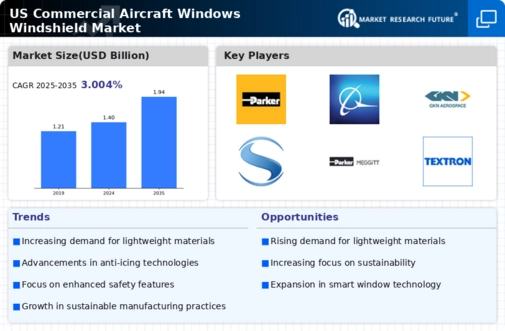Growth of the Aviation Sector
The commercial aviation sector in the US is witnessing robust growth, which is positively impacting the commercial aircraft-windows-windshield market. With an increase in air travel demand, airlines are expanding their fleets and investing in new aircraft. According to recent data, the US aviation market is projected to grow at a CAGR of approximately 3.5% over the next few years. This expansion necessitates the procurement of advanced windows and windshields that meet modern performance and safety standards. Consequently, the growth of the aviation sector is expected to drive significant opportunities within the commercial aircraft-windows-windshield market.
Rising Demand for Fuel Efficiency
the market is experiencing a notable surge in demand for fuel-efficient aircraft. Airlines are increasingly focusing on reducing operational costs, and lightweight windows and windshields contribute significantly to overall aircraft weight reduction. This trend is supported by data indicating that a reduction of just 1 kg in aircraft weight can lead to a fuel savings of approximately 0.003% per flight. As airlines seek to enhance their fuel efficiency, the demand for advanced materials and designs in the commercial aircraft-windows-windshield market is likely to grow, driving innovation and investment in this sector.
Increased Focus on Passenger Safety
Passenger safety remains a paramount concern for airlines, influencing the commercial aircraft-windows-windshield market. Regulatory bodies in the US are continuously updating safety standards, which necessitates the use of high-quality materials and designs in aircraft windows and windshields. Enhanced safety features, such as impact resistance and thermal stability, are becoming essential requirements. The market is likely to see a rise in demand for products that meet or exceed these stringent safety regulations. This focus on safety not only ensures compliance but also enhances passenger confidence, thereby driving growth in the commercial aircraft-windows-windshield market.
Sustainability Initiatives in Aviation
Sustainability initiatives are becoming increasingly prominent in the aviation industry, influencing the commercial aircraft-windows-windshield market. Airlines are under pressure to reduce their carbon footprints and adopt environmentally friendly practices. This has led to a demand for windows and windshields made from recyclable materials and those that contribute to overall aircraft efficiency. The market is likely to see innovations aimed at reducing environmental impact, such as the development of bio-based composites. As sustainability becomes a core focus for airlines, the commercial aircraft-windows-windshield market is expected to adapt and evolve to meet these new demands.
Technological Innovations in Manufacturing
Technological advancements in manufacturing processes are playing a crucial role in shaping the commercial aircraft-windows-windshield market. Innovations such as automated production lines and advanced composite materials are enhancing the quality and durability of aircraft windows and windshields. For instance, the introduction of computer-aided design (CAD) and 3D printing technologies allows for more precise and efficient production methods. This not only reduces manufacturing costs but also improves the performance characteristics of windows and windshields, making them more resistant to environmental factors. As these technologies continue to evolve, they are expected to significantly impact the commercial aircraft-windows-windshield market.






















Leave a Comment